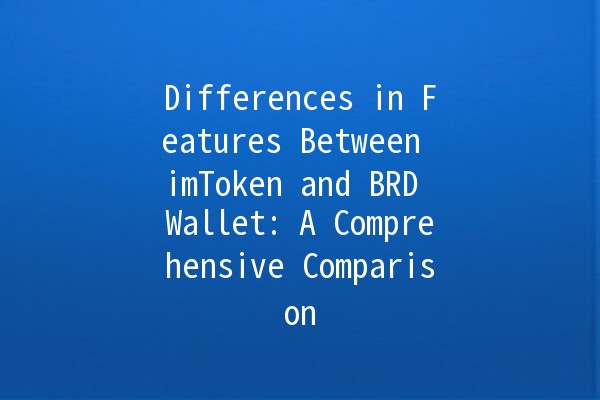In the rapidly evolving world of cryptocurrency wallets, understanding the differences between various platforms is essential for users seeking security, usability, and functionality. This article delves into the key features of two popular wallets: imToken and BRD, providing insights to help users make informed choices regarding their digital assets.
imToken is a multichain digital wallet introduced by a team based in China in
BRD, on the other hand, is a Swissbased wallet that focuses on simplicity and security. Known for its high standards of privacy, BRD allows users to control their private keys directly. Its features cater to individuals who prioritize security and ease of use.
Both wallets differ significantly in the range of cryptocurrencies they support.
imToken: imToken supports a wide array of cryptocurrencies, including Bitcoin (BTC), Ethereum (ETH), and numerous ERC20 tokens. Its support for various blockchains caters to users with multiasset portfolios, making it more appealing for those who engage in diverse trading activities.
BRD: While BRD supports major cryptocurrencies such as BTC, ETH, and others, its main focus is on Bitcoin and Ethereum. Users may find limitations if they wish to engage in trading lesserknown altcoins, as BRD’s focus is narrower compared to imToken.

When it comes to user experience, both wallets adopt different approaches.
imToken: The app features a modern interface that is intuitive and rich in graphics. Users are presented with extensive functionalities right on the main screen, allowing easy access to trading, DApps, and wallet management features. However, some newcomers may find the multitude of options overwhelming.
BRD: In contrast, BRD prides itself on its simplicity. The user interface is straightforward and focuses solely on the essentials, making it very userfriendly for beginners. This minimalistic approach helps firsttime users navigate the wallet with ease, although advanced features are somewhat limited.
Security is paramount in cryptocurrency wallets, and here is how both platforms measure up.
imToken: imToken employs robust security measures, including a hierarchical deterministic (HD) wallet pattern that generates a unique address for each transaction. Additionally, the wallet allows for biometry authentication, enhancing its security further.
BRD: The standout element of BRD's security features is that users have full control over their private keys. These keys are stored on users’ devices and are not shared with any third party. BRD also utilizes industrystandard encryption protocols to safeguard user data.
Transaction fees can significantly impact users when moving assets.
imToken: Fees on imToken can vary depending on the blockchain and the traffic at the time of the transaction. For Ethereum transactions, the wallet allows users to customize their gas fees based on desired speed and cost of transaction, which can be beneficial for frequent traders.
BRD: BRD operates with a more fixedfee structure typically associated with the Ethereum and Bitcoin networks. Users can expect reasonable fees for transactions, but they lack the customizable options that imToken provides, possibly making transactions costlier during peak times.
The ability to connect with decentralized applications (DApps) is growing in importance for many crypto users.
imToken: As one of the more integrated wallets with the DeFi (Decentralized ance) ecosystem, imToken easily connects with various DApps, providing users with access to decentralized exchanges, liquidity pools, and more. This functionality is a strong advantage for users involved in DeFi.
BRD: BRD has begun to roll out features that allow limited access to DApps. However, it is not as fully integrated with the DeFi system compared to imToken. Users who are looking to take advantage of DApps might find BRD lacking in capacity in this area.
If you deal in a broad range of cryptocurrencies, consider imToken for its extensive support. If your focus is primarily on Bitcoin and Ethereum, BRD may suffice.
For users who prioritize complete control over their private keys, BRD is preferable. imToken also provides security but depends on its centralized structure for certain functionalities.
Beginners may feel more comfortable starting with BRD due to its userfriendly interface. More experienced users might appreciate the features and flexibility offered by imToken.
If you regularly conduct transactions, investigate the essence of the fees associated with both wallets. imToken’s customizable fees might save you in the long run.
For users eager to explore the DeFi space or trade on DApps, imToken’s robust integration is a substantial advantage and worth considering.
imToken supports a large variety of cryptocurrencies, including Bitcoin, Ethereum, and many ERC20 tokens. This makes it suitable for users with diverse portfolios.
BRD keeps user privacy at the forefront by allowing users to manage their private keys independently without storing them on a thirdparty server, ensuring complete control over their assets.
Transaction speed in imToken can be adjusted based on the gas fee set by the user, allowing for quicker transactions in peak times. BRD, however, operates on the standard network fees which might slow down processing during busy periods.
While BRD has begun integrating some DeFi functionalities, it doesn’t offer the level of access to DApps that imToken provides, making imToken a more favorable choice for DeFi users.
If you are new to cryptocurrency, BRD may be the more suitable choice due to its straightforward and easytouse interface. Once you become proficient, you may explore more advanced wallets like imToken.
Yes, you can migrate from one wallet to another, but it’s crucial to securely back up your private keys or recovery phrases. Proper backup ensures you do not lose access to your assets when switching wallets.
This comparison between imToken and BRD demonstrates distinct features suited to varying user preferences. Whether prioritizing a vast array of supported currencies, userfriendliness, security, or DApp integration, understanding these differences empowers users to select a wallet that best meets their needs.